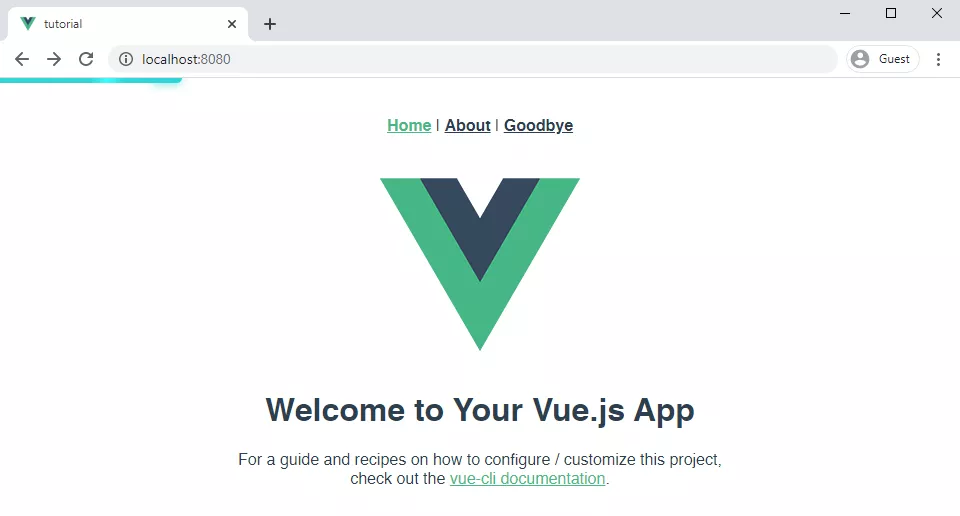您好,登錄后才能下訂單哦!
您好,登錄后才能下訂單哦!
本篇文章為大家展示了Vue 中怎么惰性加載加一個進度條,內容簡明扼要并且容易理解,絕對能使你眼前一亮,通過這篇文章的詳細介紹希望你能有所收獲。
為什么要按需加載?
Vue.js 中 SPA 的典型工作方式是將所有功能和資源打包一并交付,這樣可以使用戶無需刷新頁面即可使用你的應用。如果你沒有為了按需加載頁面針對自己的應用進行明確的設計,那么所有的頁面會被立即加載,或者提前使用大量內存進行不必要的預加載。
這對有許多頁面的大型 SPA 非常不利,會導致使用低端手機和低網速的用戶體驗會很差。如果通過按需加載,用戶將不需要下載他們當前不需要的資源。
Vue.js 沒有為動態模塊提供任何加載指示器相關的控件。即使進行了預取和預加載,也沒有對應的空間讓用戶知道加載的過程,所以還需要通過添加進度條來改善用戶體驗。
準備項目
首先需要一種讓進度條與 Vue Router 通信的方法。事件總線模式比較合適。
事件總線是一個 Vue 實例的單例。由于所有 Vue 實例都有一個使用 $on和 $emit的事件系統,因此可以用它在應用中的任何地方傳遞事件。
首先在 components 目錄中創建一個新文件 eventHub.js:
import Vue from 'vue' export default new Vue()
然后把 Webpack 配置為禁用預取和預加載,這樣就可以針對每個函數單獨執行此類操作,當然你也可以全局禁用它。在根文件夾中創建一個 vue.config.js 文件并添加禁用預取和預加載的相關配置:
module.exports = { chainWebpack: (config) => { // 禁用預取和預加載 config.plugins.delete('prefetch') config.plugins.delete('preload') }, }添加路由和頁面
用 npx 安裝 Vue router 并使用:
$ npx vue add router
編輯位于 router/index.js 下的 router 文件并更新路由,以便可以用 import() 函數代替 import 語句:
以下默認配置:
import About from '../views/About.vue' { path: '/about', name: 'About', component: About },將其改為:
{ path: '/about', name: 'About', component: () => import('../views/About.vue') },如果希望可以選擇按需加載某些頁面,而不是全局禁用預取和預加載,可以用特殊的 Webpack 注釋,不要在 vue.config.js 中配置 Webpack:
import( /* webpackPrefetch: true */ /* webpackPreload: true */ '../views/About.vue' )
import() 和 import 之間的主要區別是在運行時加載由 import() 加載的 ES 模塊,在編譯時加載由 import 加載的 ES 模塊。這就意味著可以用 import() 延遲模塊的加載,并僅在必要時加載。
實現進度條
由于無法準確估算頁面的加載時間(或完全加載),因此我們無法真正的去創建進度條。也沒有辦法檢查頁面已經加載了多少。不過可以創建一個進度條,并使它在頁面加載時完成。
由于不能真正反映進度,所以描繪的進度只是進行了隨機跳躍。
先安裝 lodash.random,因為在生成進度條的過程中將會用這個包產生一些隨機數:
$ npm i lodash.random
然后,創建一個 Vue 組件 components/ProgressBar.vue:
<template> <div :class="{'loading-container': true, loading: isLoading, visible: isVisible}"> <div class="loader" :style="{ width: progress + '%' }"> <div class="light"></div> </div> <div class="glow"></div> </div> </template>接下來向該組件添加腳本。在腳本中先導入 random 和 $eventHub,后面會用到:
<script> import random from 'lodash.random' import $eventHub from '../components/eventHub' </script>
導入之后,在腳本中定義一些后面要用到的變量:
// 假設加載將在此時間內完成。 const defaultDuration = 8000 // 更新頻率 const defaultInterval = 1000 // 取值范圍 0 - 1. 每個時間間隔進度增長多少 const variation = 0.5 // 0 - 100. 進度條應該從多少開始。 const startingPoint = 0 // 限制進度條到達加載完成之前的距離 const endingPoint = 90
然后編碼實現異步加載組件的邏輯:
export default { name: 'ProgressBar', data: () => ({ isLoading: true, // 加載完成后,開始逐漸消失 isVisible: false, // 完成動畫后,設置 display: none progress: startingPoint, timeoutId: undefined, }), mounted() { $eventHub.$on('asyncComponentLoading', this.start) $eventHub.$on('asyncComponentLoaded', this.stop) }, methods: { start() { this.isLoading = true this.isVisible = true this.progress = startingPoint this.loop() }, loop() { if (this.timeoutId) { clearTimeout(this.timeoutId) } if (this.progress >= endingPoint) { return } const size = (endingPoint - startingPoint) / (defaultDuration / defaultInterval) const p = Math.round(this.progress + random(size * (1 - variation), size * (1 + variation))) this.progress = Math.min(p, endingPoint) this.timeoutId = setTimeout( this.loop, random(defaultInterval * (1 - variation), defaultInterval * (1 + variation)) ) }, stop() { this.isLoading = false this.progress = 100 clearTimeout(this.timeoutId) const self = this setTimeout(() => { if (!self.isLoading) { self.isVisible = false } }, 200) }, }, }在 mounted() 函數中,用事件總線來偵聽異步組件的加載。一旦路由告訴我們已經導航到尚未加載的頁面,它將會開始加載動畫。
最后其添加一些樣式:
<style scoped> .loading-container { font-size: 0; position: fixed; top: 0; left: 0; height: 5px; width: 100%; opacity: 0; display: none; z-index: 100; transition: opacity 200; } .loading-container.visible { display: block; } .loading-container.loading { opacity: 1; } .loader { background: #23d6d6; display: inline-block; height: 100%; width: 50%; overflow: hidden; border-radius: 0 0 5px 0; transition: 200 width ease-out; } .loader > .light { float: right; height: 100%; width: 20%; background-image: linear-gradient(to right, #23d6d6, #29ffff, #23d6d6); animation: loading-animation 2s ease-in infinite; } .glow { display: inline-block; height: 100%; width: 30px; margin-left: -30px; border-radius: 0 0 5px 0; box-shadow: 0 0 10px #23d6d6; } @keyframes loading-animation { 0% { margin-right: 100%; } 50% { margin-right: 100%; } 100% { margin-right: -10%; } } </style>最后將 ProgressBar 添加到 App.vue 或布局組件中,只要它與路由視圖位于同一組件中即可,它在應用的整個生命周期中都可用:
<template> <div> <progress-bar></progress-bar> <router-view></router-view> <!--- 你的其它組件 --> </div> </template> <script> import ProgressBar from './components/ProgressBar.vue' export default { components: { ProgressBar }, } </script>然后你就可以在頁面頂端看到一個流暢的進度條:

頁面頂端的進度條
為延遲加載觸發進度條現在 ProgressBar 正在事件總線上偵聽異步組件加載事件。當某些資源以這種方式加載時應該觸發動畫。現在向路由添加一個路由守護來接收以下事件:
import $eventHub from '../components/eventHub' router.beforeEach((to, from, next) => { if (typeof to.matched[0]?.components.default === 'function') { $eventHub.$emit('asyncComponentLoading', to) // 啟動進度條 } next() }) router.beforeResolve((to, from, next) => { $eventHub.$emit('asyncComponentLoaded') // 停止進度條 next() })為了檢測頁面是否被延遲加載了,需要檢查組件是不是被定義為動態導入的,也就是應該為 component:() => import('...') 而不是component:MyComponent。
這是通過 typeof to.matched[0]?.components.default === 'function'完成的。帶有 import 語句的組件不會被歸為函數。
上述內容就是Vue 中怎么惰性加載加一個進度條,你們學到知識或技能了嗎?如果還想學到更多技能或者豐富自己的知識儲備,歡迎關注億速云行業資訊頻道。
免責聲明:本站發布的內容(圖片、視頻和文字)以原創、轉載和分享為主,文章觀點不代表本網站立場,如果涉及侵權請聯系站長郵箱:is@yisu.com進行舉報,并提供相關證據,一經查實,將立刻刪除涉嫌侵權內容。